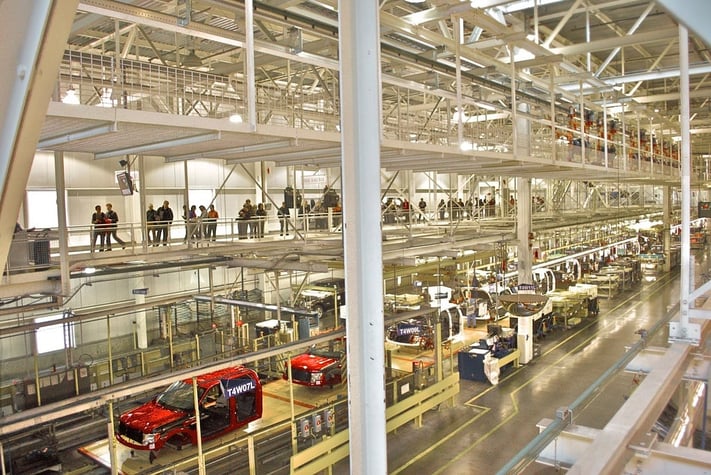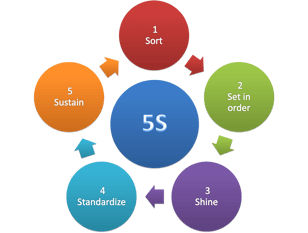5 Lean Manufacturing Tools You Should Already Be Using

Lean Manufacturing principles encourage maximum efficiency for just about any production facility. Lean Manufacturing is also more of a necessity than ever, with cutthroat competition across the manufacturing industry forcing all players to up their efficiency levels.
If you're worried that your company isn't lean enough, take a look at these five tools from the Lean Manufacturing playbook.
5S
 5S is often the launching point for businesses just starting with lean manufacturing. Much of 5S seems intuitive, but implementing each step can result in significant improvements in efficiency and quality.
5S is often the launching point for businesses just starting with lean manufacturing. Much of 5S seems intuitive, but implementing each step can result in significant improvements in efficiency and quality.
- Sort - Organize every workspace by separating the necessary (materials, tools) from the unnecessary (waste, scrap, redundancies) and remove anything unnecessary from the production area
- Set In Order - lay out the necessary inputs of production (tools and materials) in an easy, intuitive manner
- Shine - Clean the workspace and remove any clutter
- Standardize - Make a list of instructions for repeating the first three steps, so that any employee who arrives in the workspace knows exactly how to proceed
- Sustain - Rinse and repeat. Sort, Set In Order and Shine on a regular basis, so that the workspace stays clean and clutter-free at all times.
Gemba
Gemba is more of a philosophy than a concrete set of steps. Translating roughly to “the real place,” gemba encourages executives and upper management to spend as much time as possible on the shop floor, interacting with employees and witnessing the production process firsthand.
By adopting a culture of gemba, companies can improve in several ways, including:
- Building communication chains between the shop floor and the executive offices
- Promoting a more thorough understanding of issues that affect production
- Cultivating a more harmonious work environment
Kaizen
One of the cornerstones of lean manufacturing, Kaizen focuses on continuous improvement in the manufacturing process. It’s obvious that any business would want to improve their processes as much as possible, but Kaizen is more about creating an environment that allows continuous, incremental improvement. To use Kaizen, companies should:
- Promote communication between shop-floor employees and management
- Regularly request feedback from employees at all levels
- Separate, record and quantify all aspects of production
- Continually stay abreast of technological advancements
Takt Time
Takt time is the average time allowed to manufacture a product in order to match customer demand. Takt time can be calculated with a simple formula: Takt time = Time available (per period)/ Customer demand (per period). The resulting value gives manufacturers an idea of how often they should schedule the start of production for each part.
Implementation of takt time motivates manufacturers to eliminate waste in the production system, to zero in on bottlenecks, and to remove non-value-adding work from the process.
Total Productive Maintenance (TPM)
Total productive maintenance is an equipment-focused tool that aims to eliminate four things: breakdowns, slow operation, defects and accidents. Training and scheduling are two important aspects of TPM, which focuses equally on equipment operators and on management.
The following are “pillars” of TPM:
- Autonomous Maintenance: making operators responsible for cleaning and maintaining equipment
- Planned Maintenance: scheduling maintenance tasks based on likely periods between failures
- Quality Maintenance: adding error detection into the production process and using root-cause analysis to solve any problems
- Focused Improvement: encourage collaboration to regularly achieve small process improvements
- Early Equipment Management: apply knowledge of failures and issues to improve installation or production of new equipment
- Training and Education: make sure everyone, from headquarters to the shop floor, is equipped with the knowledge to implement TPM principles
- Safe and Healthy Environment: minimize hazards and risks to all employees
- TPM in Administration: apply the same set of guidelines listed above to company administration
If you're not already going Lean, it's time to get started. The name of the game is waste (or muda) elimination, and just about every business on the planet has its own version of muda. Just remember that Lean Manufacturing is a commitment that needs to be shared at all levels of the company, from the shop floor to the executive offices. It's not a product or a service you can purchase, but if done right, Lean Manufacturing can lead to massive improvements in your bottom line.
For more on lean manufacturing tools and history, click below to download our lean manufacturing infographic:
Featured photo: Ford Rouge Factory Tour by Nicole Yeary on Flickr
Tags: Lean Manufacturing, Manufacturing, Efficiency, Productivity

Written by Jeff Cook
Jeff Cook is Chief Sales and Marketing Officer for Eagle Alloy in Muskegon, MI. While enlisted in the Marine Corps Reserves, he began working at Eagle Alloy in 1986 as a snag grinder on 3rd shift after his father told him to “Get a job!” Jeff is past President of the American Foundry Society. His passions include educating young people on the careers and advancement available in the metalcasting industry.




